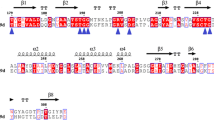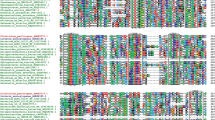Abstract
L-asparaginases are widely distributed enzymes among plants, fungi and bacteria. This enzyme catalyzes the conversion of l-asparagine to l-aspartate and ammonia and to a lesser extent the formation of l-glutamate from l-glutamine. In the present study, forty-five full-length amino acid sequences of L-asparaginases from bacteria, fungi and plants were collected and subjected to multiple sequence alignment (MSA), domain identification, discovering individual amino acid composition, and phylogenetic tree construction. MSA revealed that two glycine residues were identically found in all analyzed species, two glycine residues were also identically found in all the fungal and bacterial sources and three glycine residues were identically found in all plant and bacterial sources while no residue was identically found in plant and fungal L-asparaginases. Two major sequence clusters were constructed by phylogenetic analysis. One cluster contains eleven species of fungi, twelve species of bacteria, and one species of plant, whereas the other one contains fourteen species of plant, four species of fungi and three species bacteria. The amino acid composition result revealed that the average frequency of amino acid alanine is 10.77 percent that is very high in comparison to other amino acids in all analyzed species.
Similar content being viewed by others
References
Abuchowski, A., Kazo, G., and Verhoest, C., 1984. Cancer Therapy with Chemically Modified Enzymes. I. Anti-tumor Properties of Polyethylene Glycol-Asparaginase Conjugates, Cancer Biochem Biophys 7, 175.
Allison, J., Davidson, L., Gutierrez-Hartman, A., and Kitto, G., 1972. Insolubilization of L-Asparaginase by Covalent Attachment to Nylon Tubing, Biochem Biophys Res Commun 47, 66.
Berenbaum, M., Ginsburg, H., and Gilbert, D., 1970. Effects of L-Asparaginase on Lymphocyte Target Cell Reactions in Vitro, Nature 227, 1147.
Bodey, G., Hewlett, J., Coltman, C., Rodriquez, V., and Freireich, E., 1974. Therapy of Adult Acute Leukemia with Daunorubicin and L-Asparaginase, Cancer 33, 626.
Boyse, E., Old, L., Campbell, H., and Mashburn, L., 1967. Suppression of Murine Leukemias by L-Asparaginase, Incidence of Sensitivity Among Leukemias of Various Types: Comparative Inhibitory Activities of Guinea Pig Serum L-Asparaginase and Escherichia coli L-Asparaginase, J Exp Med 125, 17.
Broome, J., 1961. Evidence that the L-Asparaginase Activity of Guinea Pig Serum is Responsible for Its Antilymphoma Effects, Nature 171, 1114.
Broome, J., 1963a. Evidence that the L-Asparaginase of Guinea Pig Serum is Responsible for its Antilymphoma Effects. I. Properties of the L-Asparaginase of Guinea Pig Serum in Relation to Those of the Antilymphoma Substance, J Exp Med 118, 99.
Broome, J., 1963b. Evidence that the L-Asparaginase of Guinea Pig Serum is Responsible for Its Antilymphoma Effects J Exp Med 118, 121.
Bailey, T. L., & Elkan, C., 1995. Unsupervised learning of multiple motifs in biopolymers using expectation maximization, Mach Learn, 21(1–2), 51–80.
Bailey, T. L., & Gribskov, M., 1998. Combining evidence using p-values: application to sequence homology searches. Bioinformatics, 14(1), 48–54.
Tamura, K., Dudley, J., Nei, M., & Kumar, S., 2007. MEGA4: Molecular Evolutionary Genetics Analysis (MEGA) Software Version 4.0 Mol, Biol Evol, 24, 1596–1599.
Dwivedi VD, Mishra SK., 2012. Amino acid sequence analysis of glutamate dehydrogenase from different source organisms, Online J Bioinform., 13(2), 184–191
Malviya N., Srivastava M., Diwakar S.K., Mishra S.K., 2011 Insights to sequence information of polyphenol oxidase enzyme from different source organisms. Applied Biochemistry and Biotechnology, 165: 397–405.
Author information
Authors and Affiliations
Corresponding authors
Rights and permissions
About this article
Cite this article
Dwivedi, V.D., Mishra, S.K. In silico analysis of L-asparaginase from different source organisms. Interdiscip Sci Comput Life Sci 6, 93–99 (2014). https://doi.org/10.1007/s12539-012-0041-0
Received:
Revised:
Accepted:
Published:
Issue Date:
DOI: https://doi.org/10.1007/s12539-012-0041-0




